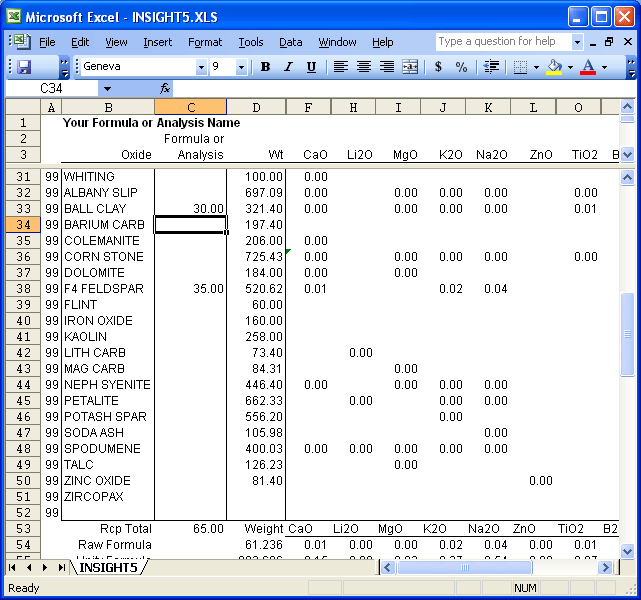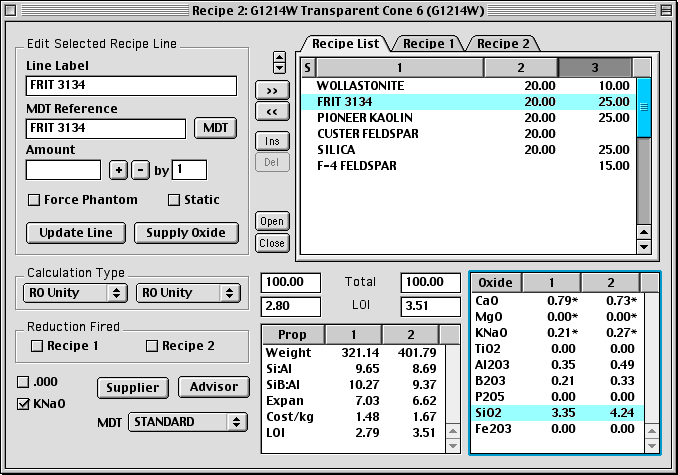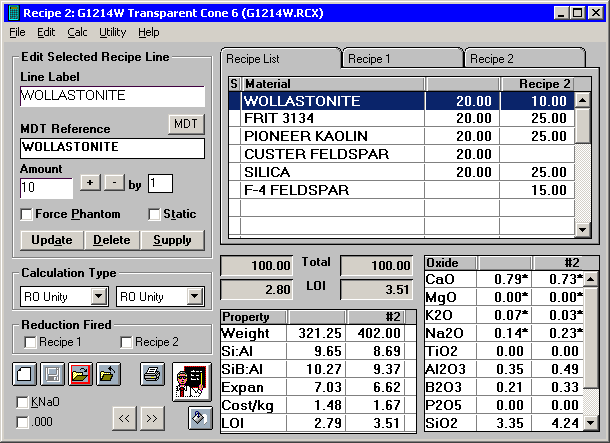| Monthly Tech-Tip | No tracking! No ads! | |
Digitalfire Insight
A downloadable program for Windows, Mac, Linux for doing classic ceramic glaze chemistry. It has been used around the world since the early 1980s.
Key phrases linking here: digitalfire insight, desktop insight - Learn more
Details
A glaze chemistry desktop application for Windows, Linux, Macintosh. It shows side-by-side recipes and their formulas. It is interactive in the sense that the chemistry impacts of changes to a recipe are immediately displayed and the process of formula-to-batch is automated. It stores recipe and material data (up to 200 materials) locally and does not communicate with any server or peer online.
Insight was first released in 1979 and has run on many operating systems since that time. As of 2021 it works on Mac, Windows and Linux. Insight is a classic glaze chemistry calculator. Its release marked the first time that people everywhere could easily do glaze chemistry, grow their understanding of glaze and learn how to solve problems like crazing, shivering, blistering, leaching, cutlery marking, etc.
From the beginning, it was designed to be able to see the recipes and chemistries of two glazes, side-by-side. This was accomplished by an in-memory materials database. Insight name-matched materials in recipes with those in the database to be able to compile the combined chemistry. Before graphical operating systems it used the box-drawing characters of the OS to create separate recipe and formula frames. Before menu-driven systems it used keyboard short-cuts to navigate through the horizontal menus at the bottom of the screen. During the early 1980s Insight migrated to color displays. Around 1990 it moved to graphical operating systems. During the 1990s, as systems became more powerful, it was able to do calculations live (the calculate-menu-choice was no longer needed). From the beginning it stored recipes in separate files on the disk (first in simple text format, then in XML). Around 2000 it moved to storing all data in an SQLite single-file database. Materials storage also evolved from text to XML to CSV files, Insight has always loaded the database at startup and maintained it in memory. The CSV format enabled people to manage their materials database outside of Insight using Excel or compatible spreadsheet software.
Early distribution of Insight was done by magazine advertising and mailing of diskettes and manuals. During the late 1980s this migrated to a BBS system that enabled customers to dial-in and search reference material. In 1995 distribution moved online and the reference materials grew to what is now digitalfire.com.
Related Information
Digitalfire Insight 4.1 running on DOS cerca 1983

This picture has its own page with more detail, click here to see it.
This was on the IBM-PC, it was introduced in 1982. Until then Insight was running on Tandy Model 1 and 3 computers. The program was shipped on floppy disks. I was lightning fast, recalculating the chemistry as fast as you could push the calculate key. It could handle as many recipes as you had disk space for and knew about 100 materials and their chemistry. However only one recipe could be displayed at a time. Many of our customers stuck with the old DOS version of Insight well into the 2000s, it could be run in Windows by double-clicking the Insight program file (here it is running in Windows 3.1). Incredibly, in 2023, there are still users of the old DOS Insight!
The main recipe window in Digitalfire Insight software

This picture has its own page with more detail, click here to see it.
Insight installs on your Linux, Windows or Mac computer. It provides a very interactive way to comparing two recipes and their calculated formulas or analyses. As you make changes in the recipe you can see how it impacts the recipes. It is ideal for demonstrating concepts like unity, analysis,
formula, mole%, LOI, formula-to-batch conversion.
The New 2020 Digitalfire Reference Library is Here

This picture has its own page with more detail, click here to see it.
It has morphed into a webapp, reflexive and menu-driven (based on Twitter Bootstrap). It now employs permanent URLs. And pages have logical, and hierarchical URLs (e.g. digitalfire.com/oxide/cao, digitalfire.com/material/feldspar). It correctly forwards 5000+ old URLs. Terms from the glossary automatically hotlink throughout (as do code-numbers for recipes, tests and firing schedules). The search field in the menu bar is area-specific (or all-area at digitalfire.com/home). Still no ads and no tracking. The UI displays from server #1, it calls the database API on #2, the email system on #3, media from #4 and insight-live.com from server #5! So it is super fast, flexible and expandable. There are new areas (e.g. projects, pictures, typecodes). Media displays better. Every page still has a contact form, so you can ask any question anywhere. What till you see what's coming!
Digitalfire Insight materials dialog window

This picture has its own page with more detail, click here to see it.
Desktop Insight remembers materials (in its database) as formulas and their formula weights. From this it can calculate the LOI. Materials can have alternate names so they are more likely to be found in calculating recipes. This dialog provides tools for adding, editing, deleting, importing and exporting materials.
Desktop INSIGHT showing formula and analysis side-by-side

This picture has its own page with more detail, click here to see it.
Desktop Insight was the first to enable users to compare two recipes and their formulas side-by-side and interactively update when recipe changes were made. It also enabled users to show formulas and analyses side-by-side.
The Digitalfire glaze calculation worksheet for Excel

This picture has its own page with more detail, click here to see it.
From the 1980s to 2000s we made this spreadsheet available. It stored materials and did the calculations in the same way that Insight did. We used it to verify that calculations were being done correctly and many customers downloaded it to learn more about the theory.
Digitalfire Insight running on a Macintosh middle 90s

This picture has its own page with more detail, click here to see it.
The Macintosh version used the same file formats as the Windows version right from the start. Macintosh customers however, were more likely to think that the program should think for them and more likely not to know which way to put the floppy disk in!
Digitalfire Insight 5.1 running on Windows 95

This picture has its own page with more detail, click here to see it.
It is not really that dissimilar to Insight as it is today. It packed alot of power but people of the time were not inclined to believe that it was possible to do the chemistry that easily, or even that the chemistry was worthwhile learning.
Digitalfire Insight 5.0 running on Windows 95

This picture has its own page with more detail, click here to see it.
This was the Insight jump from the old DOS version to a modern graphical user interface. Although Insight was available in Window 3.1, Windows 95 was the first version that was good enough that people left DOS behind.
Here is what digitalfire.com looked like in 1997!

This picture has its own page with more detail, click here to see it.
We already had a large library of educational material (the predecessor of the Digitalfire Reference Library). The Foresight product was the fore-runner to insight-live.com today. And it was free like today. And we were warning people about the importance of safe glazes and understanding the "why" questions about the ceramic process.
From Scribbles to Success: Fixing This Glaze Recipe

This picture has its own page with more detail, click here to see it.
If you do DIY pottery glazing you may have recipes scribbled onto cards like this. But the card is not the big issue here, it is that recipe! It really needs some work. Here is what could be done.
-Add this as a recipe in an account at insight-live.com (and assign it a code number) to start a testing project. Along the way document it with pictures, firing schedules, general notes, etc.
-With all that feldspar it is sure to craze, reducing the high thermal expansion K2O it contributes in favor of low expansion MgO (from talc) is the most likely fix.
-With all that clay (29 total) it is likely to crack while drying (and then crawl during firing), split it into part calcined kaolin and part raw kaolin (the ball clay is not needed).
-And those colorants: It is better to use cobalt oxide than carbonate. Perhaps the burnt umber could be increased to eliminate the need for both the manganese and iron (since it supplies both and has zero LOI). Better yet, remove all four and use a black stain (7% would likely be enough).
Inbound Photo Links
 Vintage DOS Insight runs on a web page |
Links
| URLs |
www.digitalfire.com
Digitalfire website |
| URLs |
https://digitalfire.com/insight
INSIGHT Glaze Chemstry Software |
| Glossary |
MDT
An acronym for Materials Definition Table. The XML materials database of Digitalfire Insight glaze chemistry software. |
| Glossary |
Digitalfire Foresight
Database software for DOS made by Digitalfire from 1988 until 2005 and was used to by ceramic technicians to catalog recipes, materials, test results and pictures. |
| Glossary |
Digitalfire Insight-Live
A cloud-hosted ceramics-targeted LIMS (lab info management system). It does glaze chemistry and physical testing the “Digitalfire way”. For technicians, educators, potters and hobbyists. |
| Glossary |
Tony Hansen
Tony Hansen is the author of Digitalfire Insight, Digitalfire Reference Library and Insight-Live.com, he is a long-time potter, ceramic lab-technician and body and glaze developer. |
| Glossary |
Digitalfire Reference Library
A public ad-free, no-tracking, Google destination, technical reference website for potters, educators, technicians and hobbyists in pottery and ceramic production. Since 2000. |
| By Tony Hansen Follow me on        |  |
Got a Question?
Buy me a coffee and we can talk

https://digitalfire.com, All Rights Reserved
Privacy Policy
